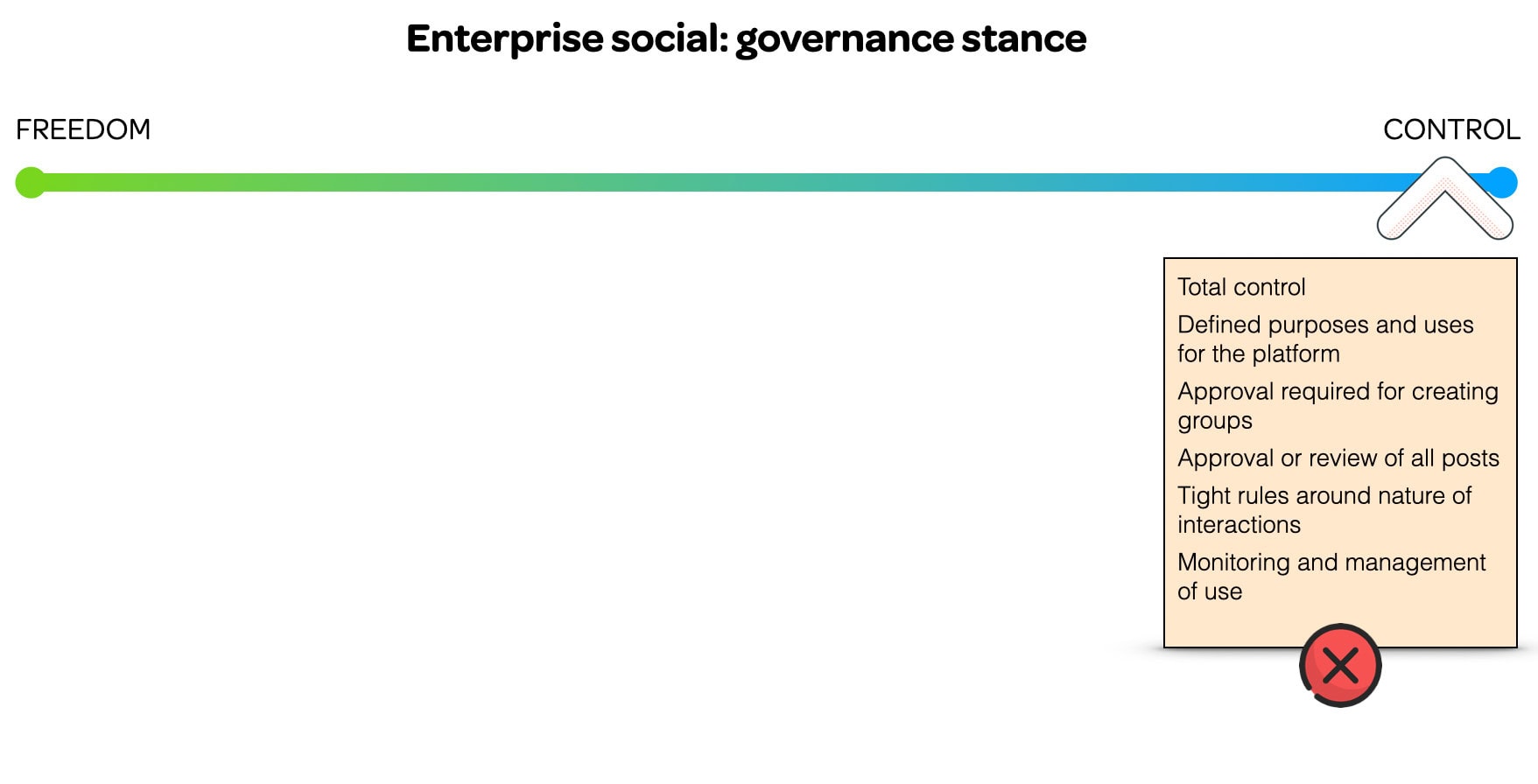
Filed under: Collaboration and social
By design, enterprise social is a very different beast to enterprise collaboration. While collaboration happens in small groups, social is inherently less structured, more open and much more fluid in use. While there largely isn’t anything to fear from enterprise social, that doesn’t mean it can or should be a rules-free ‘Wild West’.
As outlined in the Enterprise Social Framework, governance is a key enabler that’s required for social to be successful, safe and valuable. There’s no one right answer, however, on what rules and practices to put in place. It depends on the intended purposes of social and how it fits into the wider organisational culture.
A good starting point is to decide your overall governance stance for enterprise social, on a continuum from ‘freedom’ to ‘control’. The following sections explore potential approaches and their consequences:
Option 1: Complete freedom
This is the ‘anything goes’ option, characterised as follows:
- groups can be created by employees without prior review or approval
- any topic is acceptable to post, and every comment made without exception
- no monitoring or management by a central team
- no governance, documented or otherwise
Also called the ‘let a thousand flowers bloom’ approach, this leaves enterprise social to find its own path, entirely organically. The intention (hope?) is that the benefits and use cases naturally emerge, without any intervention or control, and that any risks are negligible.
Recommendation: this is a proven ‘anti-pattern’ in which organisations are exposed to the greatest risks with the least chance of success. While some organisational cultures can lead to quite toxic interactions in this governance setting, it’s more likely that enterprise social will merely ‘fizzle out’.
Option 2: Mostly free
In this approach:
- groups can be created by employees without approval
- community ‘managers’ or ‘facilitators’ are allocated to support key groups to maximise their success
- documented governance is in place, and widely socialised
- governance focuses on establishing key ‘rules of the road’ such as ensuring that interactions accord with existing employee codes of conduct
This approach may be guided by a clear set of purposes (as outlined in the Framework), but a fairly free hand is taken to the governance approach. By establishing ‘guard rails’, it becomes possible for employees to shape the use of the platform, while mitigating key risks.
Recommendation: this is a viable option to consider, depending on the overall purposes that lead to the deployment (or activation) of the enterprise social platform. Even a small number of community managers for key groups can generate great outcomes.
Option 3: Somewhat controlled
This option can be characterised as follows:
- new groups can be requested by employees, which are then reviewed and approved by a central team
- community managers or facilitators support key groups
- overall usage is monitored by a central team
- basic management is in place, such as retiring groups that are no longer being used
- there is a clear set of strategic purposes for enterprise social
- there are clear ‘what to use when’ guidelines for enterprise social, in the context of other digital workplace tools
- documented governance is in place
- governance continues to focus on establishing key ‘guard rails’ for appropriate use
This stance puts more shape around the use of enterprise social, while still leaving freedom for employees to use the platform in ways that meet their needs (or desires).
Recommendation: this is also a viable option for the governance of enterprise social, and it may suit organisations that are more tightly managed or regulated.
Option 4: Total control
If you’ve made it this far in the article, it should be pretty clear that this option is a non-starter!
Tight controls around the expected usage of the platform are valid in a limited set of circumstances, but the review of all posts is neither appropriate or practical.
Recommendation: If this is the desired governance stance, then simply don’t turn on enterprise social, and instead focus on other ways of engaging with employees.
Best practices
Consider the following when determining your enterprise social governance stance:
Shape governance to match overall purposes
The appropriate governance stance will depend on the overall objectives of enterprise social within your organisation.
If the key purposes include community engagement or organisational culture, this would suggest a stance that sits towards ‘freedom’. This allows employees to engage with and use the platform in many different ways that evolve organically over time.
Alternatively, if knowledge management is the primary purpose of enterprise social, then the governance stance would include a stronger ‘guiding hand’ that shapes interactions and uses to address organisational objectives. Note that this doesn’t necessarily imply a greater degree of control but may involve a greater level of formal organisational recognition for the role and use of social.
Match your organisational culture
It’s been said that you can’t change culture using social tools, but rather they amplify your existing culture. While that statement is overly simplistic, it emphasises the importance of aligning social governance to the prevailing culture of your organisation.
Universities, for example, have a fiercely-held commitment to open speech, which can lead to fiery debates which would be considered highly inappropriate in most other settings. Conversely, large banks are constrained by a raft of compliance rules and regulations that could easily be contravened by posts to enterprise social tools.
Note that even in these two extreme cases, the governance stance shouldn’t be pushed entirely to either end of the spectrum, and a nuanced approach will still be required.
Ensure there’s at least one community facilitator
Even in a governance stance that’s right over towards the ‘freedom’ end of the scale, formally nominate at least one community facilitator to take an overall view of the enterprise social platform as a whole. Even if they take a very light touch, this gives a single point of contact for staff and stakeholders to approach. That allows opportunities to be fully exploited (and issues dealt with promptly when they arise).
Note that initially this community facilitator responsibility will likely be a part-time responsibility of an existing role, most likely in internal communications or HR.
Be consistent
Establish governance rules and behavioural expectations right at the outset of launching a new enterprise social tool (or put them front-and-centre as part of a relaunch). Ensure that guidelines are clearly communicated and applied consistently to all employees, regardless of seniority or role.
Being consistent will help to embed the governance approach as well as demonstrating a long-term commitment to both the enterprise social platform and its use. Consistent alignment with broader organisational values and codes of conduct also help to position social as part of the business, rather than being separate from it.
Be transparent
When (or if) issues arise in the use of enterprise social tools, it’s critical that they be addressed transparently, ‘in the open’. Any problematic posts or comments should be called out as such within the platform itself, referencing back to the relevant governance elements. In the unlikely case of more extreme situations, these should be addressed via the normal people management processes that would apply to off-line behaviour.
These are far more effective approaches than quietly removing posts or only contacting employees directly, as it helps to establish clear social norms on acceptable behaviour. Greater transparency also builds confidence in the use and value of the platform.
Pick your own governance stance
The examples of possible governance stances shown above are simply that: examples.
Work with all relevant stakeholders and discuss which elements of governance will need to be more tightly controlled, and which can be left to evolve organically. Take time to listen to their concerns and make sure they’re addressed in your stance and your communication plan, and plan on revisiting that over time.
Be consistent and transparent, and with a clear governance stance, plan to make the most of enterprise social!









